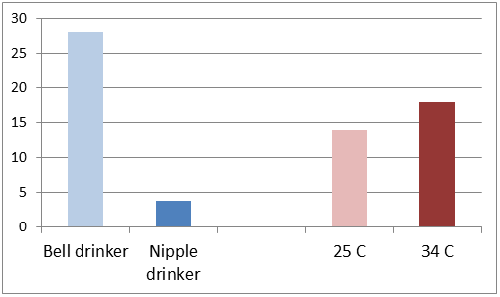



Water Intake Behaviour of Broiler Chickens Exposed to Heat Stress and Drinking from Bell or Nipple Drinkers
Drinking behaviour and water intake volume by broilers were affected by drinker type, age and temperature, according to researchers in Brazil.The aspects involved in broiler water intake are not well known, according to Dr Luis Bruno of the Centro de Ciências Agrárias (UNIOESTE) in Brazil and co-authors there and at the federal universities of Paranà, Sao Paulo (UNESP) and Paraíba.
In a paper published in Revista Brasileira de Ciência Avícola, they explain that this lack of understanding is despite the importance of water in animal nutrition and physiology. Drinking behaviour should be taken into account when deciding on different types of drinkers. Bell and nipple drinkers are the most commonly used in commercial broiler production today, they added.
In their experiment, broilers were housed in cages equipped with two different drinker types and raised at two different environmental temperatures (25 and 34°C) to evaluate water intake behaviour and volume.
Drinking behaviour was influenced by drinker type. Birds visited bell drinkers less often but presented higher total water intake per visit to the drinker than those drinking from nipple drinkers.
| Frequency of visits to drinkers (FAD; number of visits during a 10-minute interval); total water intake (TWI, mL) and water intake per visit to the drinker (WIA, mL/visit) for broilers drinking from bell or nipple drinkers and reared at 24 or 35°C) | |||
|---|---|---|---|
| Treatment | FAD (no. of visits) |
TWI (total water intake) |
WIA (water intake per visit) |
| TYPE OF DRINKER | |||
| Bell | 35.67±1.60 | 28.11±0.03 | 0.86±1.50 |
| Nipple | 156.16±5.21 | 3.72±0.0009 | 0.024±0.16 |
| TEMPERATURE | |||
| 25°C | 102.16±8.70 | 13.98±1.45 | 0.405±0.04 |
| 34°C | 89.67±5.45 | 17.85±1.74 | 0.478±0.05 |
| AGE | |||
| 7 days | 72.67±8.24 | 7.54±1.16 | 0.20±0.03 |
| 14 days | 74.83±10.02 | 10.21±1.96 | 0.32±0.06 |
| 21 days | 116.00±16.45 | 13.56±2.06 | 0.30±0.06 |
| 28 days | 97.24±13.09 | 18.75±3.54 | 0.51±0.09 |
| 35 days | 96.95±13.73 | 17.67±2.93 | 0.46±0.09 |
| 42 days | 101.25±13.32 | 21.06±3.62 | 0.60±0.10 |
| 49 days | 112.54±16.12 | 22.62±3.74 | 0.67±0.13 |
| SOURCE OF VARIATION | |||
| Drinker (D) | ** | ** | ** |
| Temperature (T) | ** | ** | ** |
| Age (A) | ** | ** | ** |
| D × T | ** | ** | ** |
| D × A | ** | ** | ** |
| A × T | NS | NS | ** |
| D × A × T | NS | NS | ** |
| CV (%) | 31.31 | 50.91 | 31.96 |
Bruno and co-authors concluded that their results suggest both broilers drinking behaviour and water intake volume should be taken into account when deciding on drinker type to install in broiler houses.
In this work, broilers using nipple drinkers may expend more energy to consume water than those drinking from bell drinkers. Furthermore, young broilers anatomy – beak size and shape - present some challenges to drink from nipple drinkers and the differences will be more profound under heat stress conditions. Adequate water supply is critical for broilers under different situations, the researchers stressed.
In their paper, the researchers added that, physiologically, these results have important implications to broiler performance because water is the most important nutrient for animal nutrition. Low water intake results in reduced feed intake, which limits the availability of water and nutrients required by biochemical and physiological function that are essential for body homeastasis and growth. Water loss is also the main mechanism used by broilers for thermoregulation.

Reference
Bruno L.D.G., Maiorka, A., Macari M., Furlan R.L. and Givisiez P.E.N. 2011. Water intake behavior of broiler chickens exposed to heat stress and drinking from bell or and nipple drinkers. Rev. Bras. Cienc. Avic., 13(2). doi: 10.1590/S1516-635X2011000200009
Further ReadingYou can view the full report by clicking here. |
September 2012








